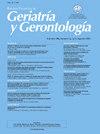老年体弱多病患者替代传统住院治疗
Q3 Medicine
引用次数: 0
摘要
越来越多的患有多种疾病和身体虚弱的老年人需要根据他们的具体需求量身定制护理模式。中级护理医院的亚急性护理单元已成为急性护理环境中传统住院治疗的有效替代方案。适当的患者选择对于早期识别可能需要长期护理的患者并确保有效的转诊至关重要。本研究的目的是:i)描述患者入院和过程指标的特征;Ii)分析与延长住院时间(≥13天)相关的潜在因素。方法对2023年1月至12月在亚急性监护室住院的208例患者进行回顾性研究。收集了人口学、临床和功能变量,以及入院原因、既往医疗资源使用、出院目的地和再入院。结果患者平均年龄85.2±14.3岁,平均vig -虚弱评分为0.39±0.13,平均合并症为6.8±2.5。中位住院时间为10,0 (P25:7;P75:13)天。67.3%的患者出院,其中85.7%的患者在13天内出院。入院前确诊为复杂慢性病例的患者更有可能平均住院时间≥13天(44.7% vs. 69.2%;P = .055)。结论:sour单元可作为急性住院治疗的有效替代方案,使多重疾病和虚弱的老年人能够进行危机管理,并促进其及时回家。本文章由计算机程序翻译,如有差异,请以英文原文为准。
Alternativa a la hospitalización convencional en los pacientes mayores con fragilidad
Introduction
The growing population of elderly people with multimorbidity and frailty requires care models tailored to their specific needs. Subacute care units in intermediate care hospitals have emerged as an effective alternative to conventional hospitalisation in acute care settings. Appropriate patient selection is essential to enable the early identification of patients who may require prolonged care and to ensure efficient turnover. The objectives of this study were: i) to describe the characteristics of patients’ admitted and process indicators and; ii) to analyse potential factors associated with prolonged hospital stays (≥ 13 days).
Methods
Retrospective study was conducted including 208 patients admitted to a subacute care unit between January and December 2023. Demographic, clinical and functional variables were collected, as well as the reason for admission, prior healthcare resourcesuse, discharge destination, and readmission.
Results
The mean age was 82,5 ± 14,3 years, with a mean VIG-Frail score of 0.39 ± 0.13 and an average comorbidity of 6,8 ± 2,5. The median length of stay was 10,0 (P25:7; P75:13) days. A total of 67.3% of patients were discharged home, 85,7% of whom did so within 13 days. Patients identified as complex chronic cases prior to admission were more likely a mean length of stay ≥13 days (44,7 vs. 69,2%; P=.055).
Conclusions
Our unit is consolidated as an effective alternative to acute hospitalisation, enabling crisis management in elderly people with multimorbidity and frailty, and facilitating a time return home.
求助全文
通过发布文献求助,成功后即可免费获取论文全文。
去求助
来源期刊

Revista Espanola de Geriatria y Gerontologia
Medicine-Medicine (miscellaneous)
CiteScore
1.90
自引率
0.00%
发文量
62
审稿时长
85 days
期刊介绍:
Una revista de gran prestigio por sus artículos originales de investigación y revisiones. Permite cubrir todas las áreas de la medicina pero siempre desde la atención al paciente anciano, y está presente en los más reconocidos índices internacionales.
 求助内容:
求助内容: 应助结果提醒方式:
应助结果提醒方式:


